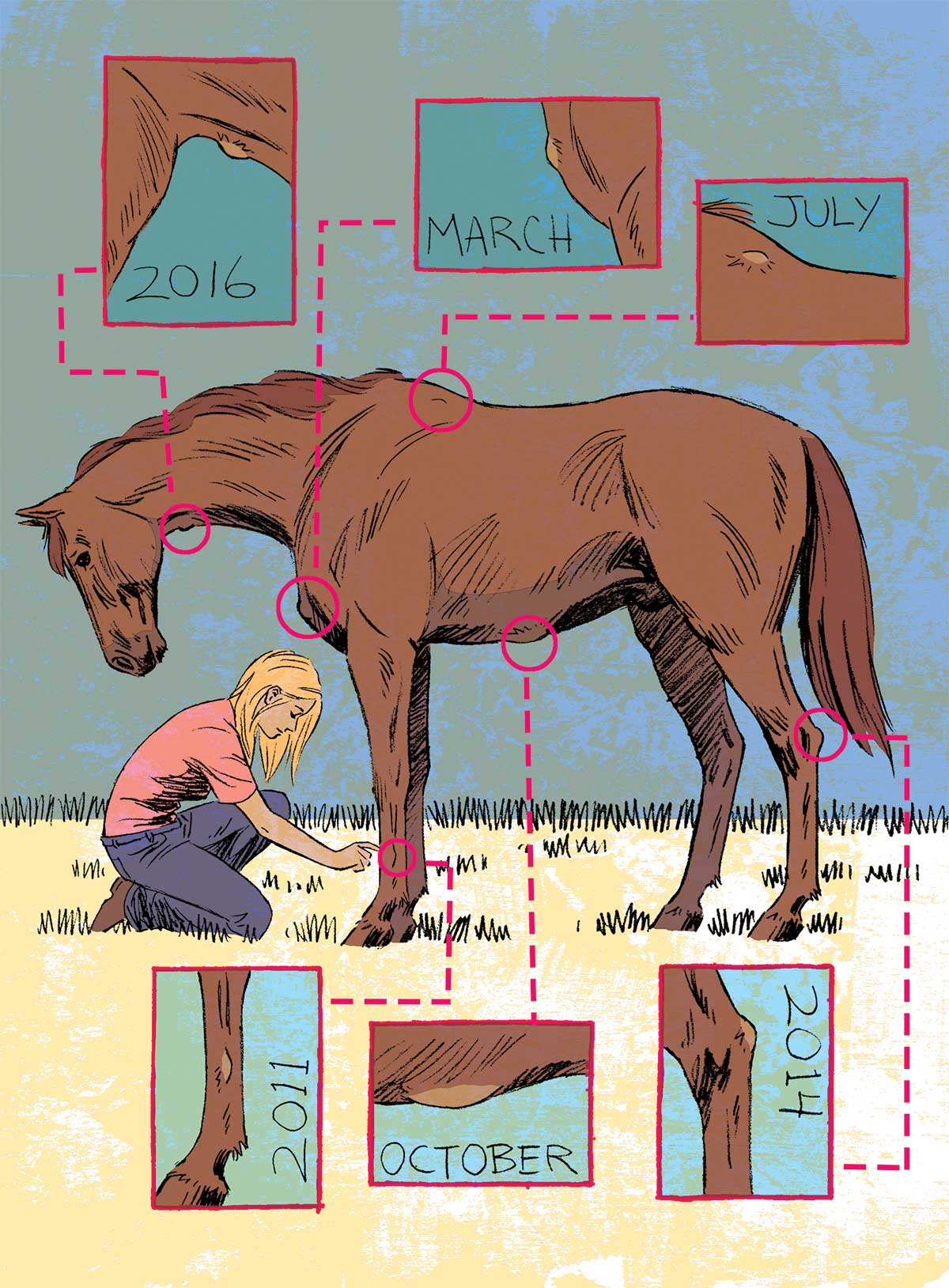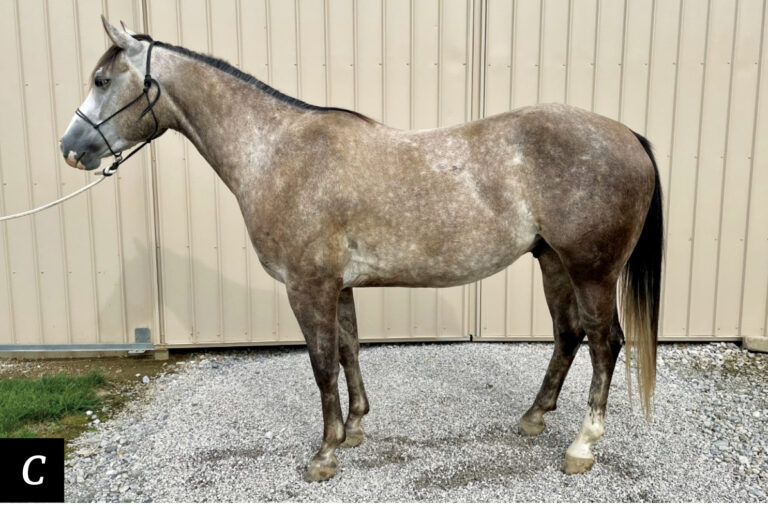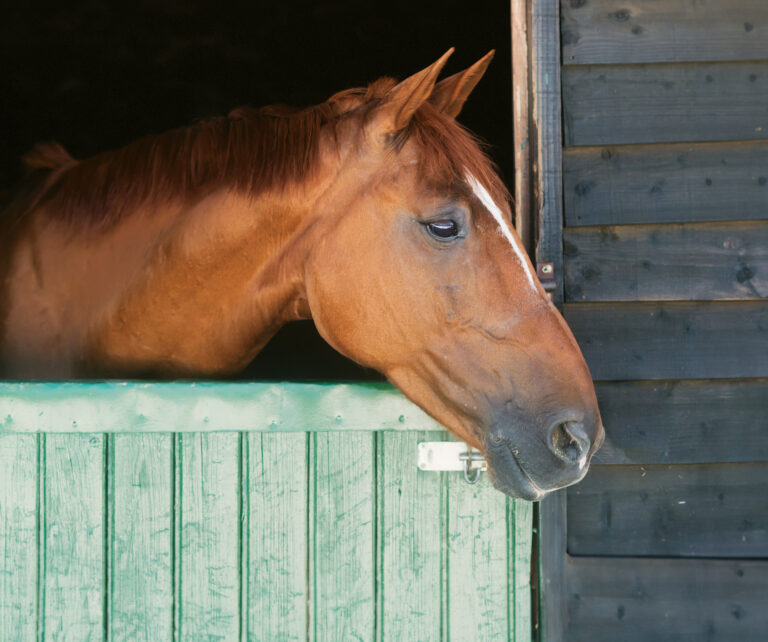“Your horse is really bumpy.” It was a text message from a trainer I’d just left my 8-year-old mare with for a couple of weeks of work. “I know,” I sighed to myself. She’d included photos of the huge splint on her right-front leg and an old scar on her left-hind. “Don’t worry,” I texted back. “Those are both old, and neither of them is a problem.”
How did I know I didn’t need to rush out to the barn to have a look? Because I know all of my horse’s lumps and bumps. Where they are, what caused them, and how long they’ve been around. But I also appreciated this trainer’s conscientious concern. It gave me confidence she was paying attention and would notice if my horse developed a new mark that might be more worrisome and need veterinary attention.
How observant are you of your horses and their condition? Have you ever noticed a new bump when saddling and wondered what it was—and if your horse needed veterinary attention? I’d guess yes.
In this article, I’ll give you a road map to the 10 most common lumps or bumps you may notice on your horse—from the tip of his nose to the end of his toes. I’ll tell you what they are, how they look, and whether you should worry. But first, I’ll give you five questions to ask yourself about the concern-causing blemish.

Questions Before Calling The Vet
If you notice a lump or bump on your horse, there are five important questions to answer before you call your vet. With these answers available, your vet will have the necessary information to help you decide if you should worry.
Question #1: Where’s the lump located? As with most things, location matters. Try to describe as accurately as possible where the lump is on your horse’s body.
Question #2: How long has it been there? This one’s simple. A new lump or bump is much more likely to be a problem than one that’s been there forever—especially if the old lump has never caused a problem in the past. Carefully examine your horse every time you groom him, and be familiar with his normal presentation.
Question #3: What’s its consistency? Gently squeeze or apply pressure on every lump you see. Tell your vet if it feels hard and bony or soft and squishy.
Question #4: Is it painful when you touch it or apply pressure with your fingers? A painful lump is more likely to be a problem than one that doesn’t elicit a pain response.
Question #5: If it’s on your horse’s leg, is he lame? Put him on the longe line and watch him jog. If he’s lame on the leg where a new lump surfaced, chances are it’s significant and should be examined.
10 Common Lumps and Bumps
Now let’s take a look at 10 of the most common lumps you’re likely to encounter. We’ll start at the head and work back and down.
Teething Bumps (Eruption Cysts)
Location: These bumps are found on the lower jaw, approximately halfway between the nose and throatlatch. They commonly appear on both sides at the same time, although one side could be bigger than the other.
What it is: These bumps appear in young horses (typically 2 to 4 years old) and are caused by pressure from permanent teeth as they push out the deciduous or “baby teeth.”
Look and feel: Teething bumps are usually about the size of a walnut or smaller, and feel very hard and bony.
Should you worry: If your horse is in the correct age range and the bumps aren’t painful when you squeeze them, they shouldn’t be a problem. In some horses, the baby teeth or “caps” will be retained (difficult to push out), and these teething bumps can become enlarged and painful due to excessive pressure. Your vet may recommend removing the stubborn caps to relieve pressure and allow permanent teeth to move in.
Abscessed Submandibular Lymph Node
Location: The submandibular lymph nodes sit between your horse’s lower jawbones.
What it is: Pus (made of bacteria and white blood cells) accumulates in a pocket within the lymph node.
Look and feel: Normally the lymph nodes will feel like a patch of small lumps and bumps—familiarize yourself with how this area feels on your horse on a normal day. When a lymph node abscesses, you’ll feel a round, hard lump—kind of like a golf ball or ping-pong ball sitting under the skin. In some cases, the abscessed node enlarges and you may see soft swelling in the surrounding tissues. In others, it can be painful to the touch, or come to a head (much like a pimple) as it prepares to burst and drain.
Should you worry: If you detect this type of abscess, call your veterinarian for advice. Many abscessed lymph nodes are benign and involve a bacterium that isn’t likely to cause significant problems. The abscess drains and resolves on its own, or your vet will lance it open to speed the process. But there’s always a concern that the bacteria involved could be something more significant, such as streptococcus equi, which causes strangles. It’s better to be safe than sorry in this case; call your vet.
Relieve pain with Bute-Less Pellets.
Pressure Bump
Location: These bumps most commonly appear on your horse’s back, under the saddle area. They can also show up under the cinch or in any other location where tack and gear contacts his skin.
What it is: Pressure and friction damage tissue layers deep beneath your horse’s skin. The resulting dead and damaged tissues coalesce to create a pressure bump.
Look and feel: Pressure bumps are firm and typically range in size, though rarely get bigger than an almond. You’ll identify them most easily when they’re in an area where saddle pressure is likely to be concentrated, such as on either side of the withers or underneath the seat. These bumps don’t typically cause your horse any pain.
Should you worry: These bumps can indicate that your tack doesn’t fit properly. It might be time to check saddle fit or outfit your horse with a pressure-distributing saddle pad. If these bumps become large or begin to lose hair, they can cause discomfort for your horse.
Seroma
Location: A seroma can appear anywhere on your horse’s body, although the most common locations are in the middle of his chest or somewhere on an upper hind leg on either side of his tail.
What it is: A seroma is a fluid-filled sac that occurs secondary to direct trauma, such as a kick from another horse. It can start as a hematoma or bruise that reorganizes into a seroma over a period of several days.
Look and feel: A seroma feels like a water balloon. It won’t bother your horse much if you push on it. If you notice it during the hematoma phase it may be hard, hot, and painful.
Should you worry: Most seromas will resolve on their own, given time and patience. Your vet may lance and drain a large seroma, although this can lead to further problems, such as an infection.
Ventral Edema
Location: Ventral edema will appear right on the middle of your horse’s belly.
What it is: An accumulation of fluid under the skin that’s settled to the lowest point of your horse’s core, thanks to gravity. The fluid most commonly originates from inflammation somewhere in the body, such as an allergic reaction or some kind of trauma. In some cases, fluid accumulates due to more serious causes such as heart failure or kidney or liver disease.
Look and feel: Ventral edema usually starts as a small lump that feels hard to the touch, but can be dented if you push on it with your fingers. It’s also called “pitting edema” and is often described as having a consistency similar to bread dough. If ventral edema becomes excessive, it’ll expand from a small lump to a plaque that can measure several inches thick and extend along the entire lower portion of your horse’s abdomen.
Should you worry: A small area of ventral edema is usually not a cause for concern—especially if it gets gradually smaller over a period of several days. If it’s persistent or large, schedule a visit with your veterinarian to rule out more serious causes.
Splint
Location: Splints can occur on the inside or outside of the front and hind legs, but are most commonly found on the inside of one of the front legs, midway between the knee and fetlock.
What it is: The small splint bones run along the back and side of both the inside and outside of your horse’s cannon bones. They end approximately two-thirds of the way between the knee and fetlock. A splint bump will appear when the ligament between these small bones and the cannon bone is stressed, or if the bone itself experiences direct trauma. The bump is due to calcification of the tissues.
Look and feel: A splint is a hard, bony bump. A fresh splint can be surrounded by a small amount of soft-tissue swelling. Splints range in size from a raisin or almond to as big as a walnut.
Should you worry: A new splint can cause lameness for a period of days to weeks. A large splint can damage the suspensory ligament, especially if the calcification extends toward the middle of the leg. Call your vet if your horse is lame. An old, cold splint that’s not sensitive to pressure is unlikely to cause any problems.
Ringbone
Location: Ringbone lumps develop in the middle of your horse’s pastern on the dorsal (or front) surface. Don’t confuse this with the bumps inside and outside the pastern joint that are a normal part of your horse’s anatomy.
What it is: Ringbone is most commonly due to pastern-joint arthritis. The bumps appear when bone proliferates as the body tries to form a “bridge” to stabilize the painful joint.
Look and feel: Ringbone is a hard, bony bump. By the time you detect it, a ringbone bump can be about the size of a grape or almond, although it can grow to walnut-size over time.
Should you worry: The short answer: Yes. Many horses with ringbone become very lame. If you detect these bumps, have your horse examined. Expect that your vet will want to take radiographs to evaluate the area.
Tendon Injury
Location: A lump or bump on the back or to the side of your horse’s cannon-bone area may mean he’s experienced an injury to one of the flexor tendons.
What it is: When tendons are first injured, torn fibers can lead to bleeding and fluid accumulation within the tissues. This fluid can create a lump. If a tendon injury is old, scar tissue may have formed.
Look and feel: A fresh tendon injury will be firm, and usually sensitive to pressure if you squeeze it with your fingers. An old tendon injury may feel almost bony, and will not be sensitive to pressure.
Should you worry: If your horse has a new, sensitive bump over the tendon area, call your vet—especially if your horse is lame. An ultrasound can tell you if the tendon has been injured and if so, how badly. This is a scenario where knowing what your horse’s legs look like on a normal day is especially important.

Scar
Location: Scars can cause lumps and bumps anywhere on your horse’s body.
What it is: A healed injury may leave behind a disorganized tissue called “scar tissue” when it heals. Scar bumps occurring over bones can be especially pronounced.
Look and feel: Scars typically feel somewhat hard and ropey. In most cases, they’re not sensitive to pressure. If you’re not sure about a bump, consider shaving the hair so you can fully evaluate the skin underneath. You may see evidence of an old wound or even old suture tracks that’ll provide confirmation of a scar.
Should you worry: Know your horse’s scars. Old scars don’t usually cause problems. If a trainer or barn manager questions whether a bump is cause for concern (as in my scenario at the beginning of this article), it’ll help if you’re familiar with what’s normal for your horse.
Tumor
Location: Like scars, tumors can appear just about anywhere on your horse’s body. If you have a gray horse, pay especially close attention to his rectum, tail, and sheath area, as this is where melanomas often appear.
What it is: A tumor is a mass of cancer cells. There are a wide variety of different equine skin tumors, including melanomas, squamous cell carcinomas, cutaneous (skin) lymphosarcomas, and sarcoid tumors. The only way to accurately identify a tumor is for your vet to collect a sample (either through a needle or by cutting out a portion of the mass) and submitting it to a laboratory for evaluation under a microscope.
Look and feel: Tumors can have a variety of different appearances, and can therefore be hard to describe.
Should you worry: If you find a lump or bump on your horse that’s new and doesn’t fit any of the other common bump descriptions, watch it carefully—especially if it seems to be growing. It never hurts to schedule a visit from your vet, who can advise if additional testing is necessary.







